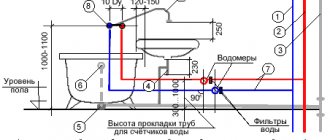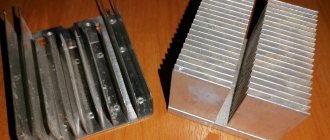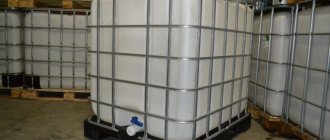For those who need to have several tools on hand at the same time for home repairs or other work, a tool belt bag is perfect. Convenient and practical, and most importantly, you don’t need to look for anything and bend over or go down the stairs every time. It probably happens to everyone that they put something on a shelf, and then you can’t find it in that place. That is why we invite you to familiarize yourself with how you can do a similar thing at home.
What it is?
A tool bag (it’s easy to make with your own hands) involves sewing an organizer with cells of different sizes. They can accommodate various devices that are often needed for minor repairs. This device will help save time searching for the necessary screwdriver or hammer. The maximum number of pockets is 10; more is not recommended. Putting too much stress on your back can affect your health, particularly leading to back problems. Of course, you can find a bag or belt for tools in a store, but the price will not always please you, not to mention the quality. In addition, their functionality may not meet your needs. Therefore, let's save, especially since the costs are low, but the benefits are many. Located at the waist - convenient and practical, no need to take time off from work.
Such devices can have several varieties:
- belt;
- vest;
- bag;
- apron.
Where can I find the pattern?
To sew a tool belt with your own hands, you need to have a pattern. Print the finished one or make it yourself from a photo. The main goal is functionality. If you decide to do it yourself, then it’s worth determining the main points:
- overall size of the belt or bag;
- number of pockets;
- the size and purpose of the compartments - for a certain tool it is important to make the correct calculation so that it does not fall out.
What is a tool belt for?
It is not always possible to use devices laid out directly at hand. When you need to move around a site or work at heights, it is advisable to use a special tool belt.
Such attributes are necessary for carrying the tool directly during the work process . A good tool belt should be functional, durable enough, and have the right number of pockets.
Materials
An equally important issue when sewing a tool belt with your own hands is the selection of material. After all, it must be strong and reliable, otherwise it may break at the most inopportune moment. It is best to use thick fabric - denim, nylon, leather, they have optimal properties for such a product. It is also worth paying attention to such a parameter as water resistance, so that everything that is there remains dry in any weather. In addition, this is not the only thing that is needed for further work. You will need:
- scissors;
- pattern;
- ruler or centimeter;
- sewing marker, soap or chalk;
- sewing machine;
- threads;
- accessories - carabiners, latches, Velcro, rivets;
- Decoration Materials.
After preparing all the necessary materials and equipment, you can proceed to the next stage.
Making bags
If you are not a sewing expert, then to make a tool bag with your own hands it is better to choose easier options. In this section we will conduct two master classes on sewing two types of tool storage. For both models, it is better to first draw a sketch-pattern for further work.
Selecting the material
When making a carrier, you can use completely different materials. However, their choice plays an important role in how long a particular tool will last you. Typically, such products are sewn from two main materials:
- Nylon. This material is the easiest to use in the future - it is not afraid of washing in a washing machine, and is lightweight in itself. It is relatively inexpensive and is used more often than the next one.
- Leather or its substitute. Leather products are distinguished by their wear resistance in use. However, such bags are much heavier than nylon ones and require proper care - this is their main disadvantage.
Sewing a belt bag
Before you sew a tool belt with your own hands, you need to make a detailed pattern. As a rule, it is not distinguished by its complexity. Usually it consists of several rectangles connected into one whole.
Important! While drawing the pattern, think about how and where all the pockets and zippers will be located.
After the pattern is ready, you can start sewing the product:
- Pin the cut out pattern to the material using safety pins, and then cut everything along the outline. When using oilcloth, there is no need to make seam allowances.
- Cut out the main part to which the pockets will be attached.
- Process all cut parts. You can use a special tape for this.
- Sew a fabric belt to the main part.
- Place the pockets in the desired locations and pin them with safety pins.
- Inspect the work carefully.
- If no errors were noticed, sew the pockets.
Important! Pockets can also be sewn on top of each other, thus increasing the capacity of the belt bag.
We sew a handbag for the car
To make a tool bag for a car with your own hands, you will need the following materials:
- Material for sewing.
- Trouser tape.
- Duct tape.
- Safety pins.
- Fabric chalk (can be replaced with a bar of soap).
- Pencil and ruler.
- Scissors and thread.
Making such a carrier is also very simple. Below is an algorithm following which you can sew this item:
- Take a piece of material from which the bag will be made, bend it to the size of the largest tool.
- Lay out all the devices for which the product is being sewn on the material. This is necessary in order to determine the number of cells and their size.
- Pin a cell of the required width for each device with a pin.
- Take out all the tools and start cutting the bag to size. To do this, you need to draw a line with chalk along which all excess will be cut off.
Important! Please note that you need to leave a hem allowance.
- Draw a line that will be located 3 cm above the largest tool - it should be parallel to the top cut of the pocket.
- Step back 2 cm from the top of the pocket, draw a line, and make a fold along it.
- Sew this fold twice.
- Remove pins and draw seam lines.
- Sew everything along the line, preferably twice for greater strength.
- Sew a flap that covers all the devices in the tool bag in the car. To do this, you need to put the part on a newspaper and, having decided on the height, trim off all excess.
- Finish the bottom and sides of the flap with braid.
- Treat the sidewalls of the lower part of the product with the same braid. As a result, you should get two parts - a valve and a pocket.
- Place the flap over the pocket, align the top edge and trim with braid.
- Sew additional small pockets onto those already created, if necessary.
Sewing
It is necessary to cut a tool belt with your own hands in accordance with the pattern. All parts need to be laid out on the wrong side of the selected material and outlined with chalk, soap or a sewing marker. Don't forget to add seam allowances - this will ensure the garment is the correct size; if you don't do this, the pockets and all parts of the waistband will be smaller. On the finished pattern, allowances may already have been added - pay attention to this. Such a nuance may affect its functionality and practicality.
We start with the belt itself, on which the compartments will be located. The wider the width of the product, the better; you should also take care of rigidity; the length is selected depending on the waist size. To make adjustments, you need to use special fittings - latches or carabiners. Velcro would also look good; if necessary, it can be easily replaced with a new one. All options can be found in stores with sewing supplies and consult with the seller, he will definitely tell you a good option from all those available.
Now let's start decorating the pockets properly:
- hem one free edge with finishing stitch;
- processing with finishing materials.
This processing option will prevent the edges of the fabric from going in different directions. And this can lead to the loss of the tool, which will be extremely unpleasant. To strengthen the pockets, you should use rivets.
When you have finished preparing all the compartments, you need to place them on the belt as the final result will look like. To try it on, pin all the parts with pins, if everything is satisfactory, then you can start sewing on the machine.
How to make a tool belt with your own hands?
Beginners are advised to choose a model that is as easy to make as possible. Before starting work, you need to find out the appropriate volume of the future product and determine the location of all pockets. For clarity, it is advisable to draw a sketch.
To make such a product, you can use various materials (for example, canvas, unnecessary jeans, straps ). To make such a belt from old jeans, you will need the appropriate material, a sewing machine and scissors.
Stages of work:
- You need to cut off the belt from jeans . Using the existing clasp, it will later be attached to the waist.
- Now you should cut out the pockets located at the back and sew them to the belt . If the pockets have rivets, this will be an added advantage when storing supplies and small tools.
- Next, you need to cut a small piece of fabric from one of the legs and fold it in half, forming a pocket. Then, leaving 2 cm at the top for attaching this pocket to the belt, sew the sides of the pocket and add 2 additional vertical stitches, thus dividing it into 2 more pockets, which can later be used for small tools.
Advice! This model can, if desired, be supplemented with various pockets to suit your taste. But it is not recommended to make more than 10 pockets.
Construction belt
A product of this type must be spacious enough to accommodate all the tools required for the job. Since a product of this kind is subjected to significant stress during use, it is necessary to use only durable, good quality elements to sew it.
A construction belt without straps (with a button) is convenient because it does not unfasten during work. The model with straps is fixed on the chest and on the back, without impeding movement during use. This allows you to use more tools in your work.
Mounting
Quite high demands are placed on such products. Such a thing must be thought out in detail to prevent a fall from a height in the event of a force majeure situation .
The mounting belt must have reliable fastenings that can be placed in different places depending on the specifics of the work.
In addition, products of this type have small compartments designed for small tools and loops for a hammer.
With such attributes you can keep a fairly large number of tools with you, which is very convenient. Products of this type are often used by electricians in their work.
Advice! It is recommended to place the hammer and chisel in such belts on opposite sides.
Types of mounting belt bags
Belts for installers are divided into:
- shoulder ones (very popular due to their low cost, but have soft, quickly deformed walls, and quickly lose their original appearance);
- waist (look like a small tablet, equipped with pockets, hooks and loops);
- in the form of a vest (the most ergonomic type of such organizer, in most cases made from a denim vest).
Reference! Professional models are made from genuine leather or rigid nylon fabric, which do not absorb moisture and oil. Such products have an impressive number of pockets and fastenings, but when filled to the maximum they can make the vest excessively heavy.
What to pay attention to
Before you start sewing your own tool belt, there are a few things to consider. They may turn out to be very important for you, so we suggest that you familiarize yourself with them in more detail:
- Make pockets on the side of the belt where your working hand is - this option will make it much more convenient to take the tool. For clarity, make a sketch, you can even make more than one.
- If in your work you often use not only small tools, but also something larger, then you should take care of mounts for them.
- Think carefully about which pocket this or that will go in, but don't forget to distribute the weight evenly.
- Unloading belts will help you reduce the load on your back from the weight of the tools.
Following simple recommendations will help you work comfortably anywhere. If you are buying a ready-made belt, bag or vest for accessories, then pay attention to how securely all the compartments are secured and the quality of the latches so that everything stays in place.
Twist, Belt or Tool Bag
twist
The first sign of comfortable and ergonomic storage and transportation of tools was the roll-up organizer. The twist organizer is a durable canvas equipped with a large number of different sized pockets for transportation and storage. The size of the rolls of tool organizers ranges from 560 x 490 mm and allows you to place the required minimum set of tools.
Undoubtedly, the ease of use of twisting is justified when carrying out any work, including auto-mechanical work. However, twisting is inconvenient to use when working at heights, when the hands must be directly in the working position. Therefore, the appearance of tool belts and bags was greeted with enthusiasm by home craftsmen.
belts
Carrying tools on a special belt is justified in the case of work in which temporary descent and ascent is undesirable.
This could be electrical work or construction activities during which it is undesirable to interrupt. The common thing that bags and belts designed for electricians, installers or builders have in common is an improved design that evenly distributes the weight of the tool. Agree that 3-5 kg. tools in weight should be distributed evenly, eliminating and minimizing excess pressure on the spine and lumbar region of the worker.
The wide cut of the belt provides rigid support to the lower spine and back. The strict ideal cut of the design eliminates the unwanted possibility of injury to the back area. The clever design of the belts is based on the use of heavy-duty materials such as tough nylon and genuine leather. The choice of such materials for the manufacture of belts and bags is justified by the properties of the material. Genuine leather and industrial nylon practically do not absorb oil or moisture. Therefore, the belt will remain dry even in the rain.
Second life for old things
You can easily make a tool belt out of old jeans. To do this, you need to use pants that have been lying around for a long time. The main part will be the upper part of the trousers, since there are already ready-made pockets there. If this is not enough for you, then you can increase their number, just do not forget about the limit - 10 pieces. It is also worth taking care of the clasp - it should be reliable, but at the same time easy to unfasten, so as not to put a lot of effort, check whether it will open on its own. The greater the weight of the vest or bag, the more secure the latch.
Tool belt
For several years, the author of this belt was interested in leatherwork. Previously, he had made himself a pair of leather tool bags, which caught the attention of one of his employees. This employee asked for a tool bag to be made for him that would be customized to his liking and also specialized for his handy tools. A colleague wanted the pouches to be attached to the waist belt and the belt to have a Star Wars theme.
This employee wanted a low belt.
Step One: Tools and Materials
For this homemade product, of course, leather is required. It cost about $70.
This amount also included:
- 10cm wide belt blank for $15 - 250g metal rivets and eyelets - sheepskin lining - several bronze details
The customer of this belt also purchased a front belt clasp.
The necessary tools were:
hammer granite slab (or other hard surface) punching punches hole punches rotary knife bevels stamps needles threads contact adhesive various dyes and oils
Step Two: Belt Design and Tools
The belt blank was 10 cm wide, which was later reduced to 6 cm, with low areas on the sides where tool pouches would be held. As stated earlier, a colleague wanted a Star Wars theme, so lightsabers were made on the back and sides with the Jedi Starbird emblem in the middle.
The belt size must be adjusted by the original buckle because the customer did not want a traditional belt buckle that is adjustable within a 30cm range to accommodate different waist sizes. Thus, it was decided to make a quick-release buckle for the belt of the waist bag, the size of which will be adjusted separately on each side. To bring this solution to life, an additional piece of leather was required.
Step Three: Finishing the Belt
First the belt was painted using acrylic leather paint. Then a clear top layer was placed on top of it. Unfortunately, there are no photographs of the painting of the belt.
A belt insert was added for aesthetic purposes. A thin piece of sheepskin was used as a liner.
It was glued on first with contact adhesive and then everything was stitched together, including the pouch mounts, buckles, and star bird medallion.
Skin contact adhesive should be applied very carefully. As soon as the parts of the belt stick together a little, it is better not to try to disassemble the gluing, as it will be very dirty. The belt buckle is connected to two separate pieces of belt leather in which additional holes have been punched for belt adjustment.
Step Four: Design of the pouch and patterns on it
The customer of this belt provided all the available tools that he would like to carry with him and asked to make a bag similar to a holster. A huge number of sketches were made, but among them there was not a single one with which he was satisfied. It was also concluded that if the waist belt looked too much like a holster, it could attract unwanted attention from security guards or police officers. Therefore, a sketch was taken as a basis, which least of all resembled a holster with a weapon. It was decided to make two separate bags, which will be on different sides. One pouch is for his hand tools, the other is for his tape measure, calculator and notepad.
After finalizing the design, it was decided to make patterns that would decorate both pouches. It took a while. While working, the author found that 3mm "faux pressed leather" was a good simulator of the thickness of real leather and helped to see how the leather would fit together. The author had previously made ductwork from sheet metal, so he was used to planning seams, overlaps, and generally being able to visualize how a flat piece of material would need to be bent to make a three-dimensional shape.
Also, the author is not very good at speed stitching, so he always punches his sewing holes in advance. If you also have similar problems, then you must be especially careful to ensure that the holes line up and look even.
Step Five: Assembling and finishing the pouch
Once the pouch mock-up pieces were laid out, punched for stitching, and painted, it was time to assemble it. Overall, this is the easiest part of making a belt. Sewing the flashlight holder was a little tricky because you had to thread the needle through the cylindrical part with your fingertips. The outer piece of leather, which held the screwdriver, mirror and pencil, was specially wetted. Unfortunately, these images are not available. Essentially all the work happened as follows. The skin was soaked in warm water for a few minutes and then stretched over the tools. The wet leather was secured around the tools and left to dry. After the pieces were all sewn together, the piece was rubbed with a little foot oil to moisturize the leather and keep it supple.
As the author said at the beginning, he is not a leatherworking specialist. However, if he could make such a homemade tool belt out of leather, then anyone can. It just takes patience, time, and trial and error.
Source
Become the author of the site, publish your own articles, descriptions of homemade products and pay for the text. Read more here.
Original ideas
You can sew a tool belt with or without a pattern. Ideas for this should be taken from the Internet or you can come up with something new yourself. For example, take an old belt, attach thick fabric to it and sew on pockets from a briefcase or pants that have been lying around for a long time. This option is interesting and does not require a lot of time and money. Everyone has things in their closet that are unsuitable for wearing. This way you can give them a second life and get rid of unnecessary things.
A good option for a tool belt (everyone can make one with their own hands) of a small size would be an old and small men's bag. The handle needs to be cut in the middle and carabiners or latches attached. This option will require practically no effort from you, because all the compartments are already ready and you don’t need to look for a pattern, you don’t need to sew anything.
As you can see, there are many options, the main thing is to choose the most optimal one for yourself.











